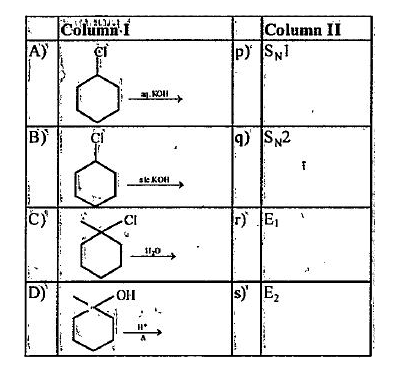Assertion : Simple carbanions are usually pyramidal but allyl carbanion is a planar species.
Reason : All the carbon atoms in allyl carbanion are sp2-hybridized.Solution in Malayalam
Statement 1 is True, statement 2 is True, Statement 2 is Correct explanation for Statement 1.
Statement 1 is True, Statement 2 is True, Statement 2 is NOT a correct explanation for Statement 1.
Statement 1 is True, Statement 2 is False.
Statement 1 is False, Statement 2 is True.
The correct Answer is:B
Allyl carbanion is stabilized by resonance.
Topper's Solved these Questions
- ISOMERISM AND REACTION MECHANISMBOOK - BRILLIANT PUBLICATIONCHAPTER - ISOMERISM AND REACTION MECHANISMEXERCISE - LEVEL - III (Linked Comprehension Type) (Paragraph I)
3 Videos
- ISOMERISM AND REACTION MECHANISMBOOK - BRILLIANT PUBLICATIONCHAPTER - ISOMERISM AND REACTION MECHANISMEXERCISE - LEVEL - III (Linked Comprehension Type) (Paragraph II)
3 Videos
- ISOMERISM AND REACTION MECHANISMBOOK - BRILLIANT PUBLICATIONCHAPTER - ISOMERISM AND REACTION MECHANISMEXERCISE - LEVEL - III (Matching Column Type)
6 Videos
- HYDROGENBOOK - BRILLIANT PUBLICATIONCHAPTER - HYDROGENEXERCISE - LEVEL -III ( Linked Comprehension Type)
8 Videos
- ORGANIC CHEMISTRY : SOME BASIC PRINCIPLES - PART I (NOMENCLATURE) BOOK - BRILLIANT PUBLICATIONCHAPTER - ORGANIC CHEMISTRY : SOME BASIC PRINCIPLES - PART I (NOMENCLATURE) EXERCISE - LEVEL-III
45 Videos
Similar Questions
The leaving group is that functional group which is ejected with electrons of the o-bond in a reaction. Better the leaving group, faster is the reaction. The relative leaving abilitiy of the leaving group X in (R-X) is increased by:
i. The polarisability of (R-X) bond ii. The degree of stabilisation through solvation of X.
iii. The strength of (R-X) bond. iv. The stability of XΘ.
The leaving group tendency is also called fugacity.
Which statement is wrong?
View SolutionStability of carbocations depends upon the electron releasing inductive effect of groups adjacent to positively charged carbon atom involvement of neighbouring groups in hyperconjugation and resonance.
From the following resonance structures of CH3−⋅⋅O⋅⋅−+CH2 predict which of the structures is more stable? : CH−3O−+CH2 , CH3−+O⋅⋅=CH2, CH2=−O⋅⋅−CH3 , All are equally stable
View SolutionMatch the following Column I and Column II :

View SolutionThe volume of 10 volume H2O2, solution that decolourises 200 ml of 2NKMnO4, solution in acidic medium is:
View SolutionGive the IUPAC name of the following compound:

View SolutionAssertion: tert-Butyl carbanion is less stable than methyl carbanion. Reason: The +1 -effect of the CH_(3) groups tends to stablize the tert-butyl carbanion.
View SolutionAssertion A phenyl carbanion (C_(6)H_(5)^(-)) is more stable than a benzyl carbanion (C_(6)H_(5)CH_(2)^(-)) Reason In benzyl phenyl carbanion the negatively charged carbon has hreater s-character than the same in benzyl carbanion.
View SolutionAssertion : Alkyl carbanions like ammonia have pyramidal shape.
Reason : The carbon atom carrying negative charge has an octet of electrons.
View SolutionCarbon atom in methyl carbocation and methyl carbanion is _____ and ______ hybridised :
View SolutionStatement-1. Simple carbanions are usually pyramidal but allyl carbanion is a planar species.
Statement-2. All the carbon atoms in allyl carbanion are sp2-hybridized.
View SolutionAssertion: Alkyl carbonaions like ammonia have pyramidal shape.
Reason: The carbon carrying negative charge has an octet of electrons.
View SolutionAssertion: Alkyl carbonaions like ammonia have pyramidal shape.
Reason: The carbon carrying negative charge has an octet of electrons.
View SolutionAssertion (A): Allyl carbanion (CH_(2) = CH- CH_(2)) is more stable than CH_(2)-NO_(2) Reason (R) : On CH_(2)-NO_(2) , only -I effect of No group is present while is allyl carbanion resonance is present
View SolutionThe negatively charged carbon atom in the carbanion is in sp^(3) hybridisation. Its shape is pyramidal or tetrahedral with one lone pair
View SolutionThe order of stability of the following carbanions
(I) o-nitrobenzyl carbanion (II) m-nitrobenzyl carbanion
(III) p-nitrobenzyl carbanion (IV) Benzyl carbanion
View Solution(i) Only carbocation form by homolytic cleavage of bond. (ii) By heterolytic cleavage of bond, the carbocation or carbanion are formed. (iii) The carbon of carbanion is sp^(2) and carbon of carbocation is sp^(3) . (iv) Carbon of carbanion is sp^(3) and carbon of carbocation is sp^(2)
View Solution
